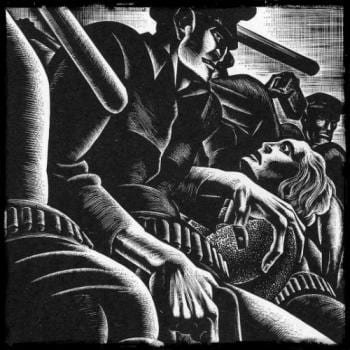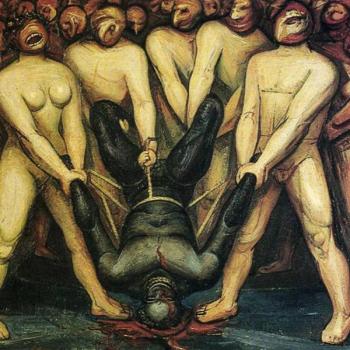Previously: Steve Bannon’s Second Coming
Bannon at the Vatican
 In the summer of 2014, Steve Bannon delivered closing remarks to a small conference on “alleviating global poverty” hosted by the Dignitatis Humanae Institute (DHI) in a small marble palace tucked deep within the Vatican. Bannon spoke via Skype from Los Angeles. This address came to the attention of the world in the days following the 2016 presidential election in a now-famous Buzzfeed article entitled This is How Steve Bannon Sees the Entire World (you can listen to the unedited audio of the talk here).
In the summer of 2014, Steve Bannon delivered closing remarks to a small conference on “alleviating global poverty” hosted by the Dignitatis Humanae Institute (DHI) in a small marble palace tucked deep within the Vatican. Bannon spoke via Skype from Los Angeles. This address came to the attention of the world in the days following the 2016 presidential election in a now-famous Buzzfeed article entitled This is How Steve Bannon Sees the Entire World (you can listen to the unedited audio of the talk here).
There was both less and more than meets the eye in this Bannon speech. He was addressing DHI in his professional capacity as the Executive Chairman of Breitbart, and probably the most interesting insights emerged from Bannon’s assumption that Breitbart’s rising moment of nationalist, populist savagery conformed to the goals and worldview of an allegedly principled and philosophically pure Catholic lay organization with transnational aspirations.
Zelig-like, the media-savvy Bannon remains, five years later, omnipresent, the crafty mole burrowing just beneath the surface of the political landscape, geolocating via some subterranean, glandular network of pheromonic exchange that connects him to a vast underworld of unsavory associates. Bannon is at all times, creepily, not unlike Pennywise the Clown, both everywhere and nowhere, dabbling at any given moment in a dozen different ethno-nationalist, anti-globalist theories, conspiracies, plots, and mercenary adventures.
And for this reason, weirdly, Bannon may presently be the most politically and intellectually significant vessel for the ideas powering authoritarian, illiberal nationalist movements in Europe, in the United States, and in portions of Latin America. Like Robby George, with whom he otherwise shares little dispositionally or intellectually, the unraveling of Bannon’s mind discloses a set of threads connecting us to the important historical, institutional, and individual sources of our present discontent. These threads include the “clash of civilizations” argument of Samuel Huntington, the Thomist natural law philosophy that has captured our politics and our courts, and the Catholic concept of the imago dei that connects us to the Creator but at the cost of separating us from the Creation.
But What of the Dignitatis Humanae Institute?
Dignitatis Humanae Institute (you can call it the Human Dignity Institute if you want) is a quirky lay Catholic NGO with ties to the European Parliament and the Vatican, based in Rome, and headed by Benjamin Harnwell, a converted Catholic (aren’t they all) and formerly active member of the British Conservative Party who identifies with the Austrian-Libertarian school of economics associated with Mises and Hayek. Harnwell’s much mocked and maligned plan to relocate DHI to the decaying Trisulti medieval monastery in the mountains outside Rome that would also serve as a gladiatorial training ground for right-wing culture warriors brought new attention to his relationship with Bannon, who underwrote the scheme until it recently collapsed when its own decadent financial underpinnings came to light.
Bannon and Harnwell have long been close, and in recent years Harnwell has adopted Bannon’s predilections for layered shirts and swept-back hair. The DHI website (which hasn’t been updated in years and is, in its own way confirmation of the kind of spiritual grift to which Bannon is drawn) profligately features a photo of Bannon informing us that “Harnwell’s the smartest guy in Rome. He’s always a tough guy – he comes across as a monk, but he’s actually a very tough guy.” Indeed (and weirdly), we can see some of that toughness, and a sense of the deeper political currents driving the DHI agenda, in an old post from the Institute about “subversive external influences” in Macedonian civil society of “stateless meddler” and “cultural imperialist” George Soros (also republished in pro-Russian news agency, Eurasia Review).
Canon law fiduciary and flame-throwing Cardinal (and Pope Francis nemesis) Raymond Leo Burke served until recently as President of the DHI’s Advisory Board, and by way of promoting this relationship the DHI website shares with us Cardinal Burke’s long keynote before the First Annual Rome-Life Forum in May 2013. Salient themes of this speech for exposing the deeper structure of the Steve Bannon worldview include: 1) reverence for the divine essence within each human life (and human life only), as mediated by Jesus Christ (and Jesus Christ only); 2) disdain for rampant secularization (and dechristianization) in the world, characterized by spiritual emptiness, moral relativism, material hedonism (rule of the flesh), and a culture of death; and 3) evangelization of the “gospel of life” based on the “natural moral law.”
The bulk of Cardinal Burke’s speech/sermon concerned Natural Law, as the expression through which reason can comprehend, accept, and fulfill the responsibility to love, serve, defend, and promote human life, in Christ. To this pre-Enlightenment pillar of Catholic legal traditionalism, we’ve already spilled much ink. For now, it may suffice to note this distillation of Catholic traditional beliefs contains many profound and beautiful insights regarding our flawed, fallen, imperfect existence as human creatures, most specifically the oft-stated command and commitment to serve the least among us. But as we might expect, much of this language is also coded to capture a deeper, more hidden, and darker agenda which exploits the fraught intersection between human sexuality and human conception.
Bannon’s Brain
Let’s dismiss an important misconception. Bannon is obviously smart (as those who know him reported after Trump appointed him Chief White House Strategist following the election), “perhaps the smartest” in his Harvard Business School class, “the most well-read person in Washington,” the “Rain Man of nationalism,” devouring works of history and political theory “in like an hour”), but not evidently smarter than lots of people, and the media he savages and mocks has perhaps given him too much credit for reading real books and for having real ideas, presumably as a way to account for the visionary and prophetic alignment between the storyline in Bannon’s head prior to the 2016 election and the surprising and unexpected outcome that folded, in virtually every one of its details, into the narrative Bannon had foretold.
Now clearly there was a fair amount of post hoc ergo propter hoc going on in retrospective accounts of what actually transpired (this Hollywood Reporter puff piece, along with the follow-on books by celebrity journalist Michael Wolff illustrates the point), and the reality of the cause and the effect will probably take decades to properly establish itself. But Bannon believes he has earned the right to own the narrative, and he and his compadres have been happy to bludgeon everyone else with his version of events, which conveniently anoints him, in a moment of establishment uncertainty, as a counter-culture sorcerer or soothsayer.
Steve Bannon may indeed be a savant. But one would not reach that conclusion from reading the transcript of his remarks to the Dignitatis Humanae Institute. These remarks, as it turns out, represent a hodgepodge of logically disconnected statements that, while in some cases individually plausible and compelling, are, taken together, neither historically accurate nor coherent at the level of narrative (or even myth), and are, moreover, morally challenged almost to the degree of being depraved.
The shards of truth that Bannon offers, sometimes spastically in this address, are absolutely not the basis for leading, governing, or even pitchfork-reaming a vast and powerful nation at an historically and existentially pivotal moment. But these statements are – regarding the Church Militant, the New Barbarity, and History as a Reaping and a Sorting, as an apocalyptic succession of judgments – absolutely consistent with the backwards-looking, cruel and frozen perspective on human life, and on created life, consistent with natural law and with an authoritarian and top-down Catholic edifice that uses a concept of the Law Revealed to punish and sacrifice the small, marvelous creatures and creations of the world at the altar of an abstract and capricious all-mighty Creator whose “love”, whose “goodness”, more often than not feels like a savage indifference, premised perhaps on irony, but more likely on a cavernous emptiness that we fill with our own fevered dreams.
Capitalisms Good and Bad
At the Vatican, speaking before an audience focused on the material and spiritual nexus of poverty, Bannon smoothly thread the needle with a trenchant overview of three kinds of capitalism and wealth creation, one of which is good and two of which are bad. The good kind of capitalism he refers to as “enlightened” capitalism, and while Bannon never clearly states precisely what he means by enlightened capitalism, one can easily deduce its outlines from its effects.
Enlightened capitalism, when constructed properly, is a vehicle for the working class and the middle class of a society to receive fair rewards for their labor. In other words, the existence of a stable, prosperous, and growing middle class, bounded on one side by a constrained and docile (because yoked to the promise of entry themselves into the middle class) impoverished social layer, and on the other side by an animated and spirited (but not too animated or spirited) leadership class whose own success is somehow tied to the solvency of the middle-class dream. “That capitalism really generated tremendous wealth. And that wealth was really distributed among a middle class, a rising middle class, people who come from really working-class environments and created what we really call a Pax Americana. It was many, many years and decades of peace.”
The “bad” capitalisms – “crony” capitalism and “libertarian” capitalism – represent deviations from or corruptions of the Platonic ideal of enlightened middle-class capitalism. State-sponsored capitalism in China and Russia and crony capitalism in Argentina are “brutal” forms of capitalism where the many produce wealth for the few, where the system only benefits intersecting groups of political, business, and military elites and their families, and “doesn’t spread the tremendous value creation throughout broader distribution patterns that were seen really in the 20th century.” Ayn Rand style libertarian capitalism, toward which populist conservatives and younger people in the United States and Europe who favor “personal freedom” have gravitated, objectifies people as commodities who possess no intrinsic worth (here Bannon invokes Marx’s ideas about worker exploitation as mere production factors).
There is some epic confusion in this Bannon narrative about the species of capitalism. At one point in the speech, noting the centenary of the murder of Archduke Ferdinand that precipitated World War I, he characterized the 20th century as an unprecedented catalog of carnage. Shortly thereafter, he invoked enlightened capitalism as the source of a global Pax Americana that “was many, many years and decades of peace.” Bannon also sometimes conflated his two species of bad capitalism, reducing them to a collective “unmooring” in which all transactions become financially engineered securitization opportunities, individuals are stripped of their inherent, spiritual value and objectified as commodities, and the “party of Davos” dictates its transcendent globalized will via centralized instruments of government that deprive ordinary men and women in the “heartlands” of nations around of the world of the opportunity to “comport their lives” as they see fit.
But, generally, so far, so good. There really is not much in this analysis to dispute. Indeed, if Bannon had been content to sit with this perspective on capitalism, which is almost anodyne, there might not be much to discuss. Even (or perhaps especially) with the infusion of a populist, class-war, pitchfork pungency, few Americans on the right or left, then or now, would challenge the assumptions of this analysis. And clearly, many sensible policies exist to restore to its foundations an “enlightened” middle class capitalism that many politicians across the political spectrum would accept, under the right circumstances. But Steve Bannon was addressing a fringe Catholic organization at the Vatican, and we quickly learn that capitalism and poverty were not really his concerns, and that to the extent he argued for class warfare, the war he envisioned was the middle class against the poor.
Judeo-Christian Apocalypse and Mayhem
We inhabit stratified physical and mental worlds, and what we quickly realize from his Vatican address is that Bannon’s economic ideas are superstructural to his ideas about cultural and spiritual decay. For Bannon, the foundations of enlightened capitalism and political freedom and stability are Judeo-Christian and Northern European. During this address, Bannon’s conversations about capitalism insistently veer off the rails to engage far more cataclysmic themes more in tune with Cardinal Burke’s conceptualizations of the culture of death associated with the secularization of the West, and with the vulnerability to unspeakable evils that Islam and the Caliphate can now access via this culture of death.
“Tough monk” Benjamin Harnwell politely rephrases Bannon’s downer screed regarding the existing crisis of church, faith, the West, and capitalism. “I am particularly struck by your argument, then, that in fact, capitalism would spread around the world based on the Judeo-Christian foundation is, in fact, something that can create peace through peoples rather than antagonism, which is often a point not sufficiently appreciated.” This perspective on the historically unique capacity of Judeo-Christianity to essentially spiritualize, via its commitment to the Imago Dei within each human, otherwise corrupt and insufficient political and economic institutions, is an important trope within the Catholic human dignity community (see items 5 and 6 of the Universal Declaration of Human Dignity).
But even when served this tennis lob, Bannon could not bring himself to return serve without applying nasty and negative spin, the unmooring of capitalism from its Judeo-Christian foundations far more significant than his (vaguely Weberian) historical claim that when capitalism was “at its highest flower and spreading its benefits to most of mankind, almost all of those capitalists were strong believers in the Judeo-Christian West.” In other words, Bannon (like Pennywise), cannot wait to get to the main event, which features the claim (repeated over and over in his address) that “we’re at the very beginning stages of a very brutal and bloody conflict, of which if the people in this room, the people in the church, do not bind together and really form what I feel is an aspect of the church militant, to really be able to not just stand with our beliefs, but to fight for our beliefs against this new barbarity that’s starting, that will completely eradicate everything that we’ve been bequeathed over the last 2,000, 2,500 years.”
The unifying message of Steve Bannon’s 2014 Vatican address, then, was omnidimensional global threat and looming apocalypse. “We are in a crisis of the underpinnings of capitalism,” Bannon told his audience, “and on top of that we’re now, I believe, at the beginning stages of a global war against Islamic fascism.”











